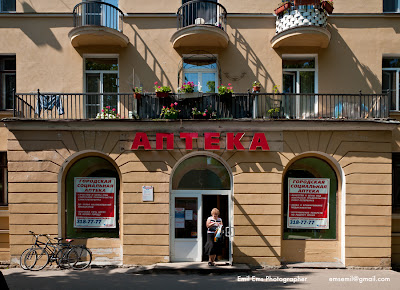 |
The Town Hall in Viborg (Viipuri), the multilingual city |
Viborg (Viipuri) was a multilingual city almost from the start. Germans in Viborg used to say “Ein echter Wiburger geht auf allen Vieren” (a true Viborg-resident walks on all fours), i.e. speaks four languages. German was the language of commerce in this town embedded for centuries in the wide network of Hansa; Russian was the language of the Czar’s military after 1721; and Swedish the sole language of the administration until 1863 when Finnish was given equal status in the Grand Duchy. Finnish was always the spoken language of most of the town’s population.
In 1870 51 % of the city’s population spoke Finnish, 16 % spoke Swedish, 24 % spoke Russian (mostly Russian military) and 5 % German (Kaj Wahlbeck, Karelen - med kärlek, p. 102). People married over language lines resulting in homes where children spoke German with some aunts and uncles and Russian with others, Finnish with friends, Swedish at school or any other of the many combinations thereof.
 |
Commerce and Industry converse in Viborg |
Villa Golicke was the summer residence of the Colliander family of St Petersburg. The poet Tito Colliander (1904 -1989) was born in St Petersburg, probably considered Swedish his mother tongue and was of the Greek-Orthodox faith. Like many other Finns, he left St Petersburg with his family during the Russian revolution, returning with a cosmopolitan outlook to the Isthmus, which was now part of independent Finland.
At Villa Golicke, he entertained Finnish poets who wrote in Swedish such as Gunnar Björling, Elmer Diktonius, Rabbe Enkell, Hagar Olsson, the Parland brothers and Edith Södergran. Villa Golicke was a “linguistic cluster” of the relatively few Swedish speaking literati on the Isthmus. There they met not only each other but formed a network with Finnish-language colleagues as well as one with prominent poets from Sweden such as Johannes Edfelt, Gunnar Ekelöf, the 1964 Nobel Laureate Eyvind Johnson and Erik Lindegren. As a multi-lingual and multi-cultural meeting place for artists and writers in the inter-war period, Villa Golicke became the cradle of literary modernism in both Finland and Sweden.
 |
Can this be Villa Golicke? |
In awe of Villa Golicke’s role in history, we headed towards Kuokkala, on the Baltic seaside just east of Terijoki, expecting to find there a Pantheon of poets. We entered an overgrown and unattended garden where we discerned a small shack behind wild-grown shrubbery. Had we come to the right place?
Clearly not, we thought. It was far too small and lacked the glass veranda, famous for its many festive parties. So we admired instead Terijoki’s legendary 35-kilometer long sand beach to which the shack had direct access through a small gate.
 |
Sand as far as the eye can see |
 |
How many wind-sailors can this house sleep? |
 |
A more expensive alternative for spending the night |
 |
The poets Elmer Diktonius and Gunnar Ekelöf (middle) with Edith’s mother in front of the Södergran house one year before it was destroyed. Photo: Berndt Flygare, Nordiska Museet |
 |
The rebuilt Villa Penaty - once a home now a museum for Ilja Repin |
 |
The artist’s study in Villa Penaty |
From Kuokkala we drove northwest along the sandy coast, feeling as though we were on the Riviera. We entered the town of Terijoki proper and saw to our surprise a well-kept Lutheran Church, right in the middle of it. It was built in 1909 in Jugend Style with Josef Stenbäck as the architect. We felt right at home.
 |
The exceptionally well-kept Lutheran Church in Terijoki |
 |
A life-saving pharmacy in Terijoki |
Large and brackish summerhouses owned by affluent St Petersburgers sprout like mushrooms in the forests and meadows of the Isthmus. You will find no pictures of these in this blog. The closer we came to St Petersburg, the more security cars and gated communities we observed. These pretentious buildings appeared to be grafted on to a foreign body.
 |
Neo-Stalinist architecture is well-preserved |
Already in the 1890s, Russia proposed incorporating the increasingly Russian speaking suburbs of Terijoki and Kivinebb (Kivennapa) into St Petersburg’s municipality, but without success. The numerous attempts then to Russify the Grand Duchy, met with strong opposition, including the assassination of the Russian Governor General Nikolaj Bobrikoff in 1904 by Eugen Schaumann. Today, the whole of the Isthmus is incorporated in St Petersburg Oblast. The economic pull from St Petersburg will inevitably incorporate the southern Isthmus even more into Russia, eliminating the last traces of cultural diversity that once characterised it. That era was ended in two steps. First, the Soviet Union closed the border in 1918. Second, it moved the border north in 1944 to include the whole Isthmus in the Soviet. Thereby, it became the dead-end and the provincial backwater that it is today.
 |
The Officers’ Casino in Terijoki – a haunted house |
 |
| Otto Kuusinen signing the pact establishing the "People's Democratic Government of Finland" |
 |
The Casino – utopia restored? |
Super stuff!
ReplyDeleteKari
Most interesting to read about this multi-lingual area and about the poetic residences of such famous writers! Being an ex-teacher of languages this information really impressed me!
ReplyDeleteVery interesting information and very nice pictures. I have to go to Viipuri before it's too late, to find if there is any reminders of my family's hamlet, the land for it donated by some Danish king ages ago. The hamlet is put out as Maelkinkylae on maps printed before WWII.
ReplyDeleteSpännade!
ReplyDeleteStort tack,
Per-Martin